
2004 Alaska Photos I
Diving the SS Aleutian
All images on this page © 2004 by Christina Young, unless otherwise noted. Background photo: Kodiak mountains and Uganik Lake from a Cessna 206 floatplane, © 2004 by Christina Young.
The word "Alaska" means "The Great Land" in the native Athabascan tongue. This sparsely-settled land, larger than Texas, California and Montana combined, will not disappoint in terms of shear scale, beauty, and spender. And that includes both wreck diving and flying. While Alaska has long been known as an aviation haven with tales of pioneer bush pilots that helped open up the wild land as an integral part of its history, it is somewhat lesser known as an attraction for wreck diving. This is primarily because of the remoteness of most shipwrecks and its small population. Before the age of airline service and the construction of the Alaska Highway during WWII, virtually the only way to get to Alaska in any reasonable amount of time was by way of ship. This included the early Russian explorers looking for fur, the prospectors looking for gold during the Gold Rush, and those headed up looking for a new life in Alaska's booming fishing industry. And wherever there are ships, inevitably there will be shipwrecks, especially in places where the weather can be unpredictably harsh at times.
In the year 2002, two Alaskan shipwreck explorers, Steve Lloyd of Anchorage and Josh Lewis of Kodiak, discovered one such Alaskan shipwreck, the pioneering Alaska Steamship Company liner SS Aleutian. The SS Aleutian was 375 feet long (5 feet shorter than a very similar vessel that was sunk off New Jersey, the famous New York and Porto Rico Steamship Company liner SS Carolina), and built in 1898 as the Havana, operated by the New York and Cuba Steamship Company.
Over the years she was sold and renamed a couple of times, ending up with the Alaska Steamship Company as the Aleutian. She sunk after striking the underwater pinnacle that now bears her name in May of 1929 in remote Uyak Bay in the northwestern part of Kodiak Island, just south of Amook Island. For a more detailed history of the SS Aleutian, its history and sinking, refer to the SS Aleutian website. Also please see Steve Lloyd's excellent piece on diving the SS Aleutian.
I was born in Alaska and have always had a special place in my heart for it. When I heard of the discovery of Alaska's largest shipwreck, I got excited about the possibility of going back to this spectacular place and diving it. It just so happened that Andrew Driver of Mad Dog Expeditions was in touch with Steve and Josh and was planning such an expedition, so I was set! And since I finally got my pilot's license, I thought what better thing to do than combine diving one of the world's premier shipwrecks with some bush and mountain flying instruction over some of the most spectacular country on earth!
In these pages I chronicle our expedition to the Aleutian, July 24-31, 2004. Please enjoy the spectacular scenery of the great land they call Alaska!
Kodiak Island, Alaska July 24-31, 2004
Kodiak Island is the second largest island in the United States, after the big island of Hawaii. It lies in the rich fishing grounds of the Gulf of Alaska, separated from the Alaska Peninsula by the Shelikof Strait (see location diagram below).

Remote Uyak Bay (pronounced "You-Yak") is in the western part of the mountainous island, and is actually a fjord coming in from the Shelikof Strait to the north. The wreck of the Aleutian lies just off the southern tip of Amook Island, about halfway down the length of Uyak Bay (see arrow on diagram below).

A diving expedition to a remote part of western Kodiak Island is no small undertaking, especially to a shipwreck in 220 feet of water that requires mixed gas to dive. Since there are no roads or trails, all gear, food, and anything else needed for the week-long expedition must be brought in by boat or float plane. Much of the logistics prior to arrival was done by shipping much of the gear beforehand to the town of Kodiak, where it was loaded along with other equipment, food, and essentials onto Josh Lewis' dive boat, the Melmar, and brought around to the other side of the island. This significantly reduced the amount of stuff that the people coming from far away places had to carry on the airlines.
| Believe it or not, this is the kind of eye candy that
you get when you fly to Alaska! I took this from the Alaska
Airlines B-737 flying from Seattle to Anchorage. This is the
Bering Glacier, the largest one in the world, and the rugged Chugach
Mountain range.
While the flight into Anchorage was beautiful and uneventful, the flight into Kodiak was a different story! Only about 50% of flights actually make it, because of the usually bad weather. We were lucky, as our flight was delayed only about 3 or 4 hours. When the airline made the boarding announcement, they indicated that the weather had risen just above minimums and therefore they would "attempt" the flight to Kodiak..... no guarantee that we wouldn't be heading back to Anchorage! When we were about 30 minutes out, the pilot said that they were on the radio with the Coast Guard... the ceilings were right at minimums, and we would make 3 attempts at landing before heading back to Anchorage. We were going in! When we finally broke out of the clouds, I could see the ocean waves right below us, and little "islets" with trees on them off to our side; we were really low! He made it on the first approach, and when the wheels finally touched down the whole plane burst out into cheers! |
 |
 |
We stayed in the town of Kodiak the first night.
Kodiak harbor is home to the largest commercial fishing fleet in the
United States. The rich waters of the Gulf of Alaska yield
abundant king crab, herring, salmon, halibut, cod, you name it!
Because of the huge fishing fleet it also has the largest Coast Guard
base, at over 1200 personnel.
You can see the low-hanging clouds in this picture, which was typical of the weather we experienced throughout our time on the island. Although I had brought a light rain poncho with me, later on I was glad that I decided to purchase a heavy-duty fisherman's-style raincoat in one of the local sporting goods stores! |
| This is the Baronof House, which was built in 1808, when Kodiak was the Russian capital of Alaska (named after Alexander Baronof, the Russian governor). It is the oldest remaining Russian structure in Alaska. When you go into the grocery stores in Kodiak, you will see many Russian canned goods and other foodstuffs for sale (labeled in Cyrillic). | 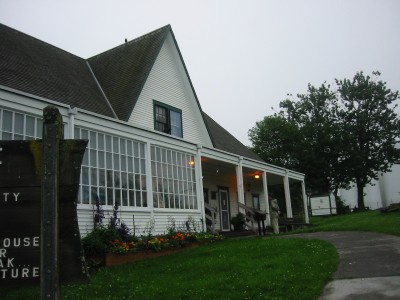 |
|
|
This is the Russian Orthodox Church in Kodiak. There is a small cemetery in back with very old Cyrillic headstones from the early 1800s. |
| This is the seaplane harbor in Kodiak, and where we will be catching our flight to remote Uyak Bay. There were some beautiful DeHavilland Beavers as well as a Found Bush Hawk, a Canadian bush plane, and from what I heard the first one in Alaska. Our flight was delayed for a couple of hours due to low ceilings (surprise, surprise!), but finally in the late morning the call came in that we were going! | 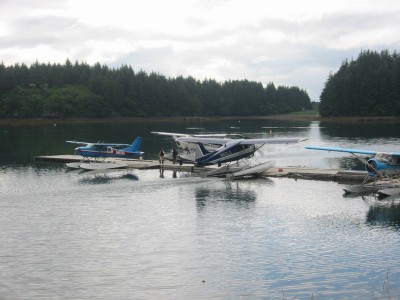 |
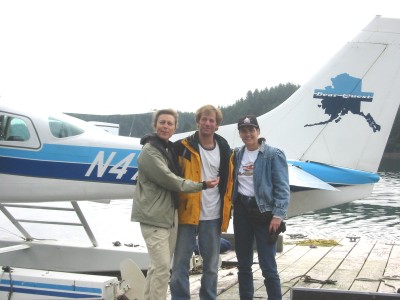 |
From left to right, this is Sondra Vitols, David
Bressler, and myself in front of the Bear Quest Aviation Cessna 206 floatplane that would be flying us to
Uyak. Our bush pilot was Dave Hilty.
Sondra was my roommate for the expedition. She was a nuclear physicist at Los Alamos until she decided to go to work on Wall Street doing complex financial derivatives instead! David also works on Wall Street, and is a mate on the Staten Island, NY-based dive boat, the John Jack. David also has some pictures from this expedition on his website. |
| Taking off out of Kodiak. | 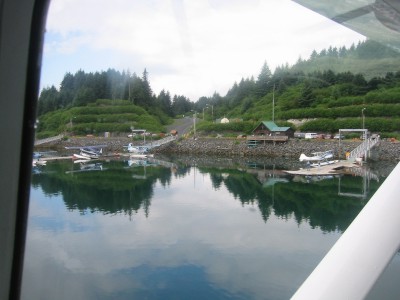 |
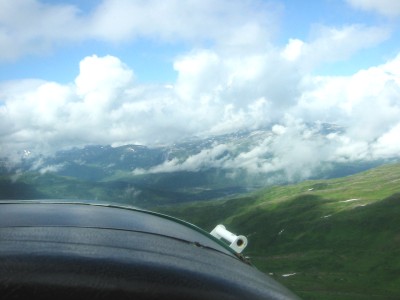 |
We fly over some very beautiful, rugged and remote terrain on the way out. |
| Approaching one of the mountain passes. Not all of the passes are "passable" today, with the low clouds. Our pilot is on the radio with other bush planes, and everyone is sharing intelligence as to which ones are socked in, and which ones can be safely flown though. | 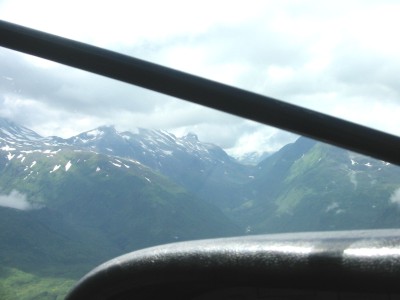 |
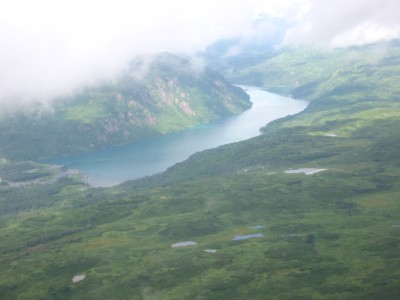 |
Passing Uganik Lake, a remote mountain lake. As you can see, Kodiak is very green with lush vegetation. It is often referred to as "Alaska's Emerald Isle". |
| The scenery just keeps getting better and better. We certainly aren't going the direct route due to the clouds and mountains! Just more time to enjoy the beautiful views. | 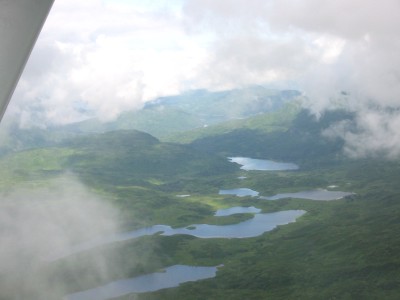 |
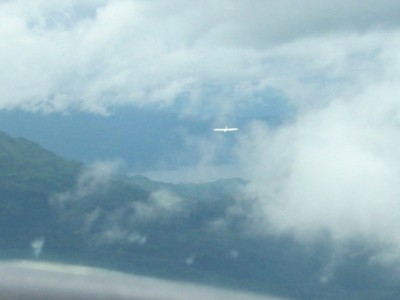 |
Another bush plane ahead of us off in the distance. |
Forward to 2004 Alaska Photos II (SS Aleutian)
![]()
Back to Home | Back to Photos | Back to Scuba Photos | E-mail Me